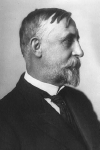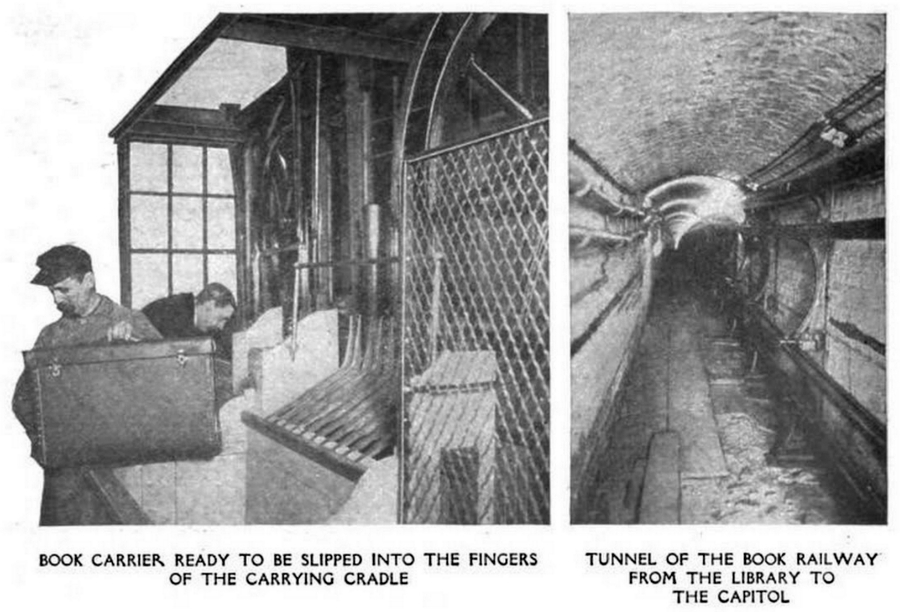 Last week, we looked at the design and building of a tunnel to move books from the Jefferson Building of the Library of Congress over to the Capitol. Today, we’ll look at its completion and use – as well as repairs that were necessary not long after it opened.
Last week, we looked at the design and building of a tunnel to move books from the Jefferson Building of the Library of Congress over to the Capitol. Today, we’ll look at its completion and use – as well as repairs that were necessary not long after it opened.
Unsurprisingly, the tunnel was of great interest to reporters of the time. In 1897, the Washington Evening Star report that the “officials of the Congressional Library building are engaged in testing the subterranean book-carrier, which is now in operation between the Capitol building and the new library building.” They further reported that it was “working perfectly” and was “expected to prove a complete success.” They did not explain the apparatus terribly thoroughly, however, writing just that it can “hardly be explained intelligibly in print,” and that it “would have to be seen to be appreciated.”
Two months later, Scientific American attempted just that, with little success, though it was at least a bit more clear than a 1901 report of the Librarian of Congress. In the latter, there are also a number of pictures that assisted in understanding the system.
Scientific American explained it thusly:
A double track runs from one terminal to the other, and an endless half-inch cable draws two baskets or carriers constantly around the track. The carrier consists of a solid back and sides and a bottom and a front formed of a series of parallel, U-shape fingers secured to the back and having no obstructions between the fingers. Strips of felt are secured in grooves in the fingers to protect the books. The carrier is pivoted to the face of a two wheel truck that is secured to the cable, the wheels of the truck being in the same vertical plane.
It goes on in the same vein for a number of further sentences, equally impenetrable. In short, the cable moved a series of carriers back and forth between the two buildings while holding the books upright.
What everyone agreed on is that it worked very well; that the tunnel was well-built and allowed “easy passage erect;” and that it was almost silent. Kudos were given to Bernard R. Green (pic), Superintendent & Engineer at the Library of Congress (h/t to eagle-eyed reader Sachchit!), who had supervised its construction.

Two images from a 1913 edition of Popular Electricity magazine, showing aspects of the book carrier. (Google Books)
The tunnel worked very well for a number of years, but the First Street Tunnel (built 1903-6) caused problems. Just ten years after its completion, it became clear that the new tunnel had badly damaged the support of the older tunnel, which had settled some two feet on the stretch above the railway tunnel. This had cracked the walls, allowing water to penetrate the tunnel, which had no way of draining. A number of times, books actually were dipped into this water as they made their way between the Capitol and the Library of Congress.
Legislation which passed on March 3, 1917, appropriated $8,500 for repairs: The result was that about ten percent of the tunnel was replaced with reinforced concrete. This tube was then supported by two concrete columns that were built down onto the top of the railway tunnel. The work was done $2,000 under budget.
Water continued to be a problem: In the 1930s, a sump pump was installed in the tunnel. Shortly thereafter, when the Adams Building was completed, it, too, was connected to the Jefferson Building by a book tunnel; In this case, a pneumatic tube was used to move the books.
When they stopped using the original tunnel is unclear, but part of it was removed when the current tunnel between the Capitol Visitor Center and the Library of Congress was built about ten years ago.
It is certainly possible that some stretch of this engineering marvel still exists somewhere underneath the east Capitol Grounds.

Thanks, great article! One correction that Bernard Green was actually the Superintendent & Engineer for the Library, not the Librarian of Congress. Herbert Putnam was Librarian from 1899 – 1939 (https://www.loc.gov/about/about-the-librarian/previous-librarians-of-congress/herbert-putnam/).
Thank you! We’ll make sure to correct the error.